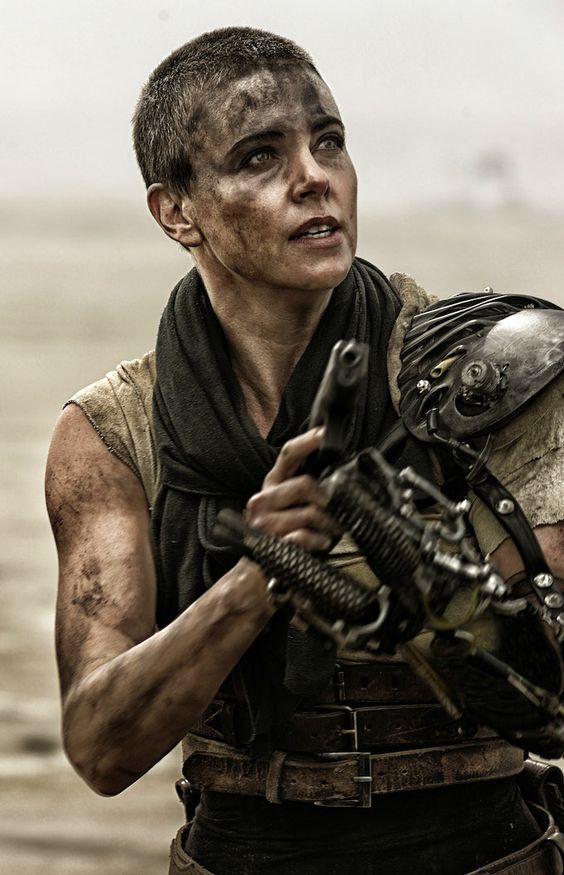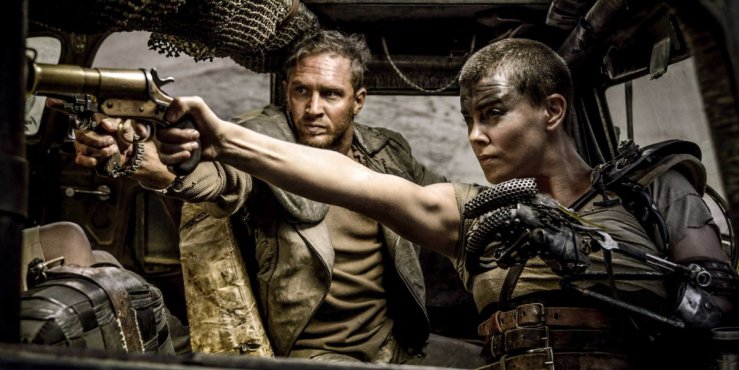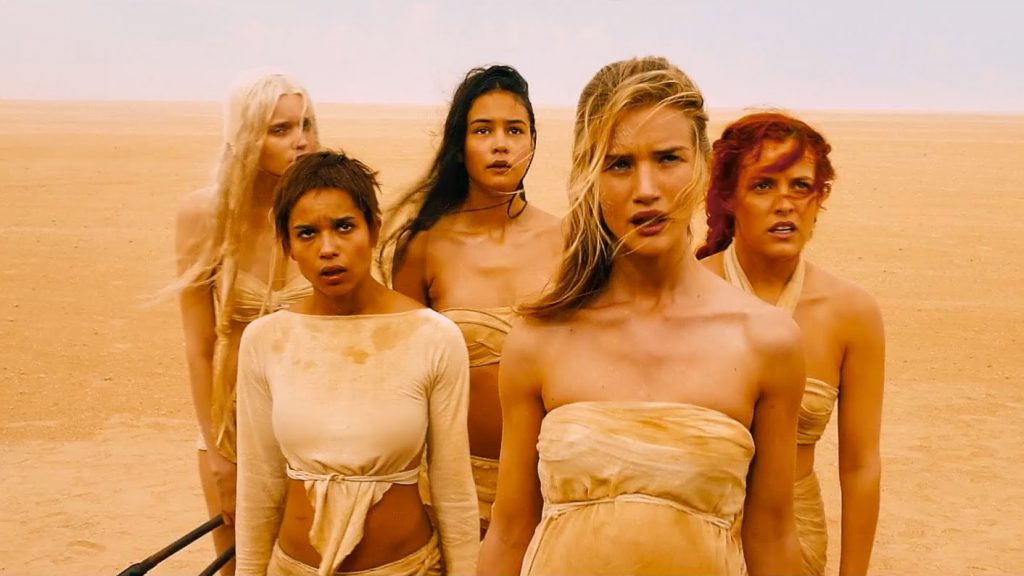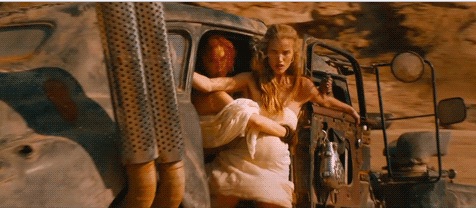Friedan and Furiosa: Challengers of the Status Quo
by Hannah K. Mapes
This paper was written as part of a writing-intensive feminist theory class. It explores the basic tenets of liberal feminism, specifically women’s equal partnership with men, the role of motherhood in determining a woman’s destiny, the power of autonomy, and how these topics are addressed in the film Mad Max: Fury Road. Author Betty Friedan is often cited because she was one of the most prominent and powerful voices in advocating liberal feminism as demonstrated in her Statement of Purpose for The National Organization of Women (NOW) and her well-known book The Feminine Mystique. Overall, this paper analyzes how the empowering tenets of liberal feminism are demonstrated in the film Mad Max: Fury Road and why more powerful and complex representations of women are needed in the media.
The pervasiveness of patriarchy and sexism is inexplicably found in nearly every part of society today and is especially prevalent in the media. Despite this, it is a rare, yet powerful thing when attention is brought to this widely unacknowledged and unrealized issue. Betty Friedan, activist and author of the Statement of Purpose for the National Organization of Women (NOW), uses her voice to demand equality and to discuss the basic tenants of liberal feminism. These tenants parallel the overarching themes found in the film Mad Max: Fury Road (Miller and Mitchell, Miller & Voeten, 2015). Both pieces use their platforms to show how deeply patriarchy runs while simultaneously exploring the ways in which women can and should demand change. The basic tenets of liberal feminism, discussed by Friedan and demonstrated in Mad Max: Fury Road, focus on women’s equal partnership with men, the role of motherhood in determining a woman’s destiny, and the power of autonomy. As a result, society is given a literal picture of presence of patriarchy and how women can fight back against these forces and also demand better and more accurate representations of women in the media.
The World of Mad Max: Fury Road
Knowing the context of this film is important in order to fully understand and appreciate this movie and its themes of female empowerment and equality in their entirety. The context of Mad Max: Fury Road, directed by George Miller, the creator of the original Mad Max franchise, is a post-apocalyptic world in which the entire earth is a wasteland, with the exception of “Joe’s Citadel” (Miller & Mitchell et al., 2015). Immortan Joe is the ruler and warlord of what remains of Earth, and within his citadel the remnants of society live and depend on him for water and food. He stands as a symbol for both patriarchy and capitalism within this world. Immortan Joe owns five women referred to as “The Wives.” They are also called “breeders” as they are held prisoner by Joe and sexually used and abused for his pleasure. Immortan Joe also has an army of men working for him known as the “War Boys,” who are taught that to die for glory is the ultimate achievement.
Imperator Furiosa is one of Joe’s lieutenants who drives a “War Rig,” a long, giant truck used to transport large amounts of gasoline. Furiosa is the only female lieutenant who has earned the reputation and trust of Immortan Joe and the War Boys. She uses this to her advantage to help organize and execute the escape of The Wives, by hiding them in her war rig and veering off from the regular route in an attempt to outmaneuver the War Boys who will surely be sent after them once Immortan Joe realizes his wives are missing (Miller & Mitchell et al., 2015). One must be able to grasp this film’s setting to fully appreciate and understand the significance of the empowered depictions of women and the implications for representations of women in the media.

“Hugh Keays-Byrne in Mad Max: Fury Road (2015)” by Jasin Boland. Source: IMDB.com. License: 2012 Warner Bros. Entertainment Inc.
Betty Friedan’s Ideology and Correlating Tenets of Liberal Feminism
Betty Friedan was a renowned activist and author of The Feminine Mystique, which many say sparked the second wave feminist movement. The ideology Friedan advocates aligns in many ways with tenets of liberal feminism.Liberal feminism is focused “on creating a completely level playing field…in terms of legal and social systems [in order to change] gender norms…and socializations” and achieve gender equality (“Feminist Perspectives,” para. 2). In Friedan’s Statement of Purpose for the National Organization of Women (NOW), which reflects tenets of liberal feminism, she clearly outlines her belief that women should have and participate in equal partnership with men. She claims that the goal of her organization is to “take action to bring women into full participation…exercising all the privileges and responsibilities thereof in truly equal partnership with men” (Friedan, 1966, p. 175).
This ideology of equal partnership with men through women’s equal responsibility and participation in all of society is reflected in the relationship between Furiosa and the Max Rockatansky, the man who comes hurtling onto the scene after having escaped being held captive by the War Boys. Max catches up to Furiosa and The Wives and attempts to take the war rig, but Furiosa convinces him that they need each other to escape saying, “You’ve already damaged one of his wives…You’re sitting on 2000 horsepower of nitro-boosted war machine. I’d say you’ve got about a five-minute head start” (Miller & Mitchell et al., 2015, “The Escape Begins”). Max realizes he will not get far without her so he agrees, letting The Wives back into the rig and Furiosa into the driver’s seat.

“Charlize Theron in Mad Max: Fury Road (2015)” by Jasin Boland. Source: IMBD.com. License: 2012 Warner Bros. Entertainment Inc. –
First Tenet of Liberal Feminism: Equal Partnership Among Men and Women
Naturally, there is no trust at first between Max and Furiosa, but their relationship and partnership evolves as the story progresses. Max has a gun trained on both Furiosa and The Wives. Yet to get through the canyon passage, Furiosa must get out to negotiate a deal, thus she leaves Max in charge of driving the rig in case something should happen to her. He accepts this responsibility realizing he still needs them and they need him. The negotiation is unsuccessful which lands Max in the driver’s seat and Furiosa in the passenger seat shooting at the motorcycle gang chasing them. This scene signifies a shift in Furiosa and Max’s relationship dynamic. Furiosa trusts Max enough to drive her rig, and Max trusts Furiosa enough to load and hand her guns while he drives so she is able to defend all of them. While they still do not completely trust each other, they are equally relying on each others’ strengths and skills for survival. Thus, this at first strained interaction begins morphing into a partnership (Miller & Mitchell et al., 2015).

“Charlize Theron and Tom Hardy in Mad Max: Fury Road (2015)” by Jasin Boland. Source: IMDB.com. License: 2012 – Warner Bros. Entertainment Inc.
Another example of the equal partnership between Furiosa and Max is portrayed in a scene at night in which the rig is stuck in the mud and the War Boys and Immortan Joe are fast approaching. Max has just fired and missed using two of the four shots left in their only rifle and is kneeling, attempting to take aim a third time. Furiosa comes up behind him and Max automatically hands over the gun to her, knowing she is the better shot. She then proceeds to use his shoulder as a sniper stand and takes out the vehicle with one shot. Max’s masculinity is not threatened when he realizes Furiosa is better at shooting than him. He relinquishes control so that she can do what she does best, thus relying on her and her skills. Similarly, Max disappears into the darkness shortly after to plant mines to slow down the approaching vehicles and then returns minutes later, having bombed the War Boys and retrieved more ammo for them. Thus, both Furiosa and Max rely on each other’s strengths and unique skills, making space for each to shine and excel in their own way. As they recognize the assets each has to offer, they develop a reciprocal relationship, each stepping up or stepping aside when necessary. Max and Furiosa continue to save each other’s lives multiple times throughout the film. A level of trust has developed, and they stop seeing each other as threats and instead start seeing each other as allies (Miller & Mitchell et al., 2015).
Similarly, an equal partnership with men is demonstrated through the participation of The Wives. Instead of being five helpless women who are simply along for the ride, Max and Furiosa rely on them to do their share. Furiosa tells the wife, Toast the Knowing, “Reload the clip” and “I need you to match every gun with its bullets” for inventory (Miller & Mitchell et al., 2015, “The Wives”). Toast is not an expert but she figures out how to reload the guns and take inventory. Additionally, Max says to them, “We need someone in the back [of the rig]” and the wife, Capable, volunteers saying, “I’ll do it.” Furiosa responds, “No!” but Capable insists telling her, “I can do it” (Miller & Mitchell et al., 2015). And she does. Thus, the women are not limited to the passive roles while Max does all the work and gets to partake in the action. Women are equally included in the work and the action. Their skills and abilities are equally trusted and relied upon, just as Friedan insists they should be.

Screenshot from “Mad Max: Fury Road – “Wives” Featurette [HD]” by Warner Bros Pictures. Source: https://youtu.be/slTH9lFJjKU. License: Standard YouTube License
These relationships fall in line with Friedan’s ideology that to obtain equality, women must accept “to the full the challenges and responsibilities they share with all other people in our society” (1966, p. 176). The Wives do not demand special treatment on the rig even though they were accustomed to pampering because of their value as women to Immortan Joe. Similarly, neither Furiosa nor The Wives act out in hate or resentment toward Max, even though their past experiences with men were horrific. These things align with Friedan’s statement that to achieve equality and “create a new image of women” change will come “not in pleas for special privilege, nor in enmity toward men…but in an active, self-respecting partnership with men” (1966, p. 177).
Addressing Opposing Views
Some may assert that if this film wanted to truly be a “feminist” film, a male should not have been one of the main characters at all. In response, I would claim that much of the beauty of this film resides in the fact that male and female relationships are depicted in a way that is rarely, if ever, seen on screen. First, there is no love story between Furiosa and Max. It is a simple, but powerful partnership built on mutual respect. Secondly, while having only females as the protagonists would be powerful to see, the fact is we live in a world with men. Therefore, seeing that a mutually respectful relationship, between two fully capable individuals, Furiosa and Max, is possible and then seeing it played out on screen is not only empowering, but inspiring as well.
This partnership based on the mutual respect of two people, gives the audience a visual illustration that not all male-female relationships must have the man as “the protector” and the female as “the victim.” This theme is commonly seen in movies, in which the female is only a peripheral character or love interest. Yet, in Mad Max Furiosa stands on her own, without a partner, and is both vital and central to the story. Friedan states it is “‘the right of every woman…to become all she is capable of becoming—on her own and/or in equal partnership with a man’” (as cited in Eisenstein, 1981, p. 179). In this way, Friedan asserts that women should be able to be who they want to be and achieve what they want to achieve, whether they do it on their own or in partnership with a man. In the case of this movie, obviously both are empowering options. However, for this film it is more powerful to see how this man fits into the narrative of these capable, complex women.
Second Tenet of Liberal Feminism: Motherhood
The second aspect relevant to Betty Friedan’s idea of liberal feminism concerns motherhood. She states, “Childbearing and rearing—which continues to be a most important part of most women’s lives—still is used to justify barring women from equal professional and economic participation and advance” (Friedan, 1966, p. 176). Thus, in this sense, Friedan suggests that motherhood which we, as a society, seem to prize above all other paths for women, can actually be used against women and keep them from being able to fully participate and progress in their careers and futures as women, essentially determining their destinies. In the same way, within Mad Max, motherhood was not only prized above all else for females but was often times forced upon women, leaving them no choice for their futures, save being mothers. In this way, their destinies were determined by their ability to fulfill the required role of “mother” (Miller & Mitchell et al., 2015).
Friedan’s theory that motherhood is highly praised yet can simultaneously cause women to be held back is reflected in the lives of Immortan Joe’s five wives. Friedan states in regard to the feminine mystique, where the sole role of women is to be a mother and wife, that “it defines woman in terms of her femininity, and this is measured in relation to being a mother and a wife, not in terms of being an independent individual” (as cited in Eisenstein, 1981, p. 184). Therefore, a woman is valued for her ability to bear children, instead of simply being valued because she is a person. As a result, women’s destinies are largely limited to motherhood, because that is the role they are most valued for.
This idea that women are valuable solely because of their ability to have children is reflected in the language used for The Wives. When the War Boys get word that The Wives have escaped, one of them says, “[Furiosa] took a lot of stuff from Immortan Joe,” to which another replies, “What stuff?” He responds, “His prize breeders” (Miller & Mitchell et al., 2015, “Chase Scene”). Thus, The Wives are not referred to as people. They are compared to animals and breeding stock. Meanwhile, as Furiosa, Max, and The Wives are being chased, the War Boys shoot at them in an effort to get The Wives back. Immortan Joe races alongside the War Boys reminding them, “Protect the assets!” indicating his concern not for the women’s well-being but for his “investments” in both their bodies and his unborn children (Miller & Mitchell et al., 2015, “Chase Scene”). Similarly, when Max first meets Furiosa and The Wives, the wife, Toast the Knowing, tells him, “Don’t damage the goods,” reminding him that to Immortan Joe they are simply incubators for his future heirs (Miller & Mitchell et al., 2015, “Escape Scene”). They are valued because of what they can give to men in the form of being wives and mothers, a reflection of Friedan’s claim.
Two of the five wives are pregnant which influences the way they are treated and viewed by Immortan Joe. During the chase, Splendid, nearly nine months pregnant, uses her body to shield Furiosa who is about to be shot. Nearby Immortan Joe who is flanking the war rig yells to Splendid, “That’s my child, my property!” issuing a not-so gentle reminder that she is not allowed to get hurt because both she and the child are his property (Miller & Mitchell et al., 2015, “Splendid’s Revenge”). Not even the child within her belongs to her. It is within this role of wife and mother, that we often lose sight of the fact that “the wife and mother” is also a human being. Splendid proceeds to climbs outside of the rig to help Max but slips and is run over by one of Immortan Joe’s vehicles. Immortan Joe collects her twisted body and has one of his men cut her open while she is still barely alive in order to remove her baby boy who died (Miller & Mitchell et al., 2015). Motherhood determined Splendid’s destiny, as she was hardly valued for anything besides what she could give and produce with her body. Friedan states, “Women must be free to choose motherhood,” and the pregnant wives were given no choice (as cited in Eisenstein, 1981, p. 192).

“Riley Keough, Zoë Kravitz, and Rosie Huntington-Whiteley in Mad Max: Fury Road (2015)” by unknown. Source: IMBD.com.
Third Tenet of Liberal Feminism: Autonomy
Autonomy is also a common theme in both Friedan’s Statement of Purpose and Mad Max: Fury Road. Friedan insists we must “confront…the conditions that now prevent women from enjoying the equality of opportunity and freedom of choice which is their right…as human beings” (1966, p. 176). In the case of Mad Max, we see a serious issue with The Wives’ complete lack of autonomy. They were imprisoned, raped, and impregnated by Immortan Joe. Thus, the decision to leave him demonstrates their strides to exercise autonomy.
After The wives escaped, Immortan Joe races to the room where the girls were kept. On the walls, the girls have written “Our babies will not be warlords” and “We are not things” (Miller & Mitchell et al., 2015, “The Wives Escape”). These powerful words reflect their realization that they are people and not just “things.” During this scene, Immortan Joe is confronted by the girls’ caregiver. She forcefully tells him, “You cannot own a human being! Sooner or later someone pushes back! They begged [Furiosa] to go!” (Miller & Mitchell et al., 2015, “The Wives Escape”). Again, we see that although the girls were supposed to be helpless, they fought back by organizing their escape and asserting their personhood and autonomy.
Another scene demonstrating The Wives’ newfound autonomy occurs after the escape, when the girls are helping each other cut off their metal, toothed chastity belts with bolt-cutters (Miller & Mitchell et al., 2015). This powerful picture displays the girls freeing themselves from the power and control of Immortan Joe, and thus exercising their autonomous right to control their own bodies. Later on, Furiosa shares part of her story with Max, explaining how she was taken from her home and mother at a young age and given to Immortan Joe, similar to the stories of The Wives (Miller & Mitchell et al., 2015). An important facet of this film lies in the acknowledgement of the sexual slavery and horrific abuses that both Furiosa and The Wives experienced, without a graphic depiction of these abuses onscreen. Max believes Furiosa and The Wives’ stories and the abuses they faced as sex slaves, without it being unnecessarily played out on screen. Instead the women’s stories are told and believed, allowing us to see them not as victims but as independent, complex beings, exercising their autonomy and challenging the patriarchal status quo.
Conclusion
Overall, Friedan highlights important aspects of liberal feminism that are reflected in the film Mad Max: Fury Road. The similar idea of equal partnership with men is depicted through the relationships between The Wives, Furiosa, and Max, as they act together as allies, respecting what the other has to offer. Additionally, the idea of motherhood as the driving factor of a woman’s future is explored, as well as the right of women to have autonomy over their bodies and their actions despite the patriarchal culture that tries to limit them and their choices. Ultimately, Mad Max brings to life the liberal feminist ideals Friedan advocates, by presenting a powerful and literal picture of what patriarchy is while simultaneously empowering women to challenge and change the status quo. This film challenges the status quo for women in the media by broadening our ideas about what women can accomplish, how varied and complex they can be, and changing the tired and lazy trope of one-dimensional female characters. We can no longer abide by the flat, helpless depictions of women and girls. It is time to follow in the footsteps of Furious and demand more—more autonomy, more complexity, and more diversity.
References
Eisenstein, Z. (1981). The Radical Future of Liberal Feminism (1986 ed.). Boston: Northeastern University Press.
Feminist Perspectives. (2015). Wikigender. Used under CC BY-NC-SA 3.0. Retrieved from http://www.wikigender.org/
Friedan, B. (1966). Statement of Purpose. In W. Kolmar & F. Bartkowski (Eds.), Feminist Theory: A Reader (3rd ed., pp. 175-177). New York, New York: McGraw-Hill.
Miller, G. (Director), & Mitchell, D., Miller, G., & Voeten, P. (Producers). (2015). Mad Max: Fury Road [Motion picture on DVD]. Australia and United States: Roadshow Films, Warner Brothers Film.
Hannah Mapes is an undergraduate student majoring in social work and minoring in women’s studies at the University of Georgia. She plans to pursue her master’s in social work and is interested in working with those experiencing homelessness and those in the foster care system.
Citation style: APA
